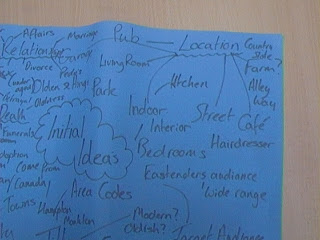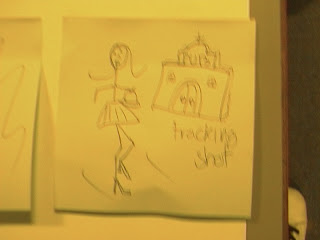As part of our research into how our poster should look, each member of Armadillo Productions has individually analysed a poster advertising a soap opera or a TV show with an open narrative. We have also looked at a poster created by a past media student for their G324.
Eaton (previous student)

This past AS media group created the soap opera called Eaton. It shows the basic information needed for effective advertisement such as date, time and channel. As well as including the unconventional web address.
There are few positives about this poster. It clearly has a wide range of character ages connoting the show is targeting no particular audience, but instead all audiences. The background is original, taking the characters out of their sets/environment and placing them in this grey, dark world. This works well with the title, the red outline of Eaton making the title bold and eye catching.
However, despite these good features this poster is poorly developed. The colouring of each character makes it obvious each shot was taken in different locations. They should have taken this shot as a group photo then added the background. This would avoid the awful colouring of characters. Also, looking at the bottom of the poster you can see sudden cuts of the characters bodies, showing the characters were poorly cut out of their photos. This suggests the poster was rushed and as a result looks unprofessional.
Scott Collins
- - - - - - - - - - - - - - - - - - - -
Hollyoaks
The Hollyoaks poster is mocking other soaps such as Eastenders and Coronation Street on characters and locations. The picture on the left shows old, fat, grotesque stereotypical British soap opera characters. They look dirty, vile and unhealthy. If you compare this to the Hollyoaks picture you can see the characters are glamorous, attractive and young. They are not stereotypical to soap opera characters and from first glances connote which audience the show targets. The colour comparison from the picture from the left to the one on the right is huge, easily making Hollyoaks seem much more glamorous. Even the dog characters have a huge difference: one is ugly and peeing on a carpet showing little respect and the other is cute, clean and even in fashion wearing doggy clothing.
The characters that stand out are the two women wearing red dresses. The fat, old one looks horrible and even the ‘nice’ red dress can’t connote glamour or beauty. Her laugh is hugely unattractive and is misplaced, for she is in public. The young, blonde woman however looks like something out of a film; she is attractive and looks extremely glamorous. The laugh of this young woman is a polite smile, much more suited for public, this connotes that the woman has some class.
The drastic difference with both locations connotes a lot of information.
Mainly that the old, dungy, stereotypical British pubs are a thing of the past because Hollyoaks, with its photoshopped interior location, will glamorize British Soap operas forever. Everything from the chairs, flooring, tables, wall paper and lights are very modern, sending enigma coded information that this soap is for the young, ‘cool’ average teenager/young adult.
The slogan ‘RUB SOME HOLLYOAKS ON IT’ easily helps connote that Hollyoaks isn’t just good television, but instead it will transform your life.
Many mise en scene factors have been incorporated during the poster's development. Colours for instance are a huge feature. Hollyoaks uses bright red with connotations of love, lust and evil, blue which connotes youthfulness and silver and gold with connotations of glamour. This compares to the traditional soap opera dirty red with connotations of old, dead glamour, brown connoting boredom and the old and other dark colours connoting negativity in general.
Scott Collins
- - - - - - - - - - - - - - - - - - - -
The Only Way is Essex
Though not a soap opera, we can still use The Only Way is Essex as an example as it has an open narrative, a continuous and opening editing style and also includes the same themes, such as relationships, seen with soap operas today. The post also includes minimal text and bold images.
Charlotte Morrison
- - - - - - - - - - - - - - - - - - - -
I have chosen to analyse a poster for Neighbors. Although it is not a brand new soap opera it has moved channel. Therefore this poster not only advertises the soap opera but also the change. This poster also includes very little text and replies on the images to advertise the soap.
Emily Wallace
- - - - - - - - - - - - - - - - - - - -
I have analysed a poster for a new series called 'Minder'. Although the poster is not advertising a soap opera, this analysis would be relevant as our group is creating a poster display for a brand new show.
The main colour of the poster is white, which has connotations of innocence. This juxtaposes with the bruise under the eye of the man on the left side of the poster, which shows that the show contains violence. The font is printed in black and both men are wearing black suits. This conflicts with the connotations of innocence that white is associated with, as black connotes death. This suggests that the show may be about crime/law.
The character on the left looks bruised and battered and is looking at the second character angrily. This suggests that the two characters know each other and are linked in the show's storyline (eg. partners in crime, good friends, enemies, etc.).
The font used in the poster is associated with the 'PRIVATE' or 'CONFIDENTIAL' words stamped on case files and private documents. This suggests that the show is about mystery and crime. The unusualness of the characters being stuck to some kind of billboard or wall tells the audience that the show includes adventurous and funny situations.
The background colour is quite bright and eye-catching, and attracts viewers to the poster display.
The tagline of the poster is 'Same old London. Brand new MINDER'. This tells the viewer where the programme is set and gives the audience the impression that this show will bring something new to the table by turning 'same old London' into a fresh and exciting setting for a new show.
The amount of writing on the poster is minimal, but all the key information the viewer needs in present. This allows the audience to focus on the visual display and colours as opposed to the writing.
The characters in the poster display are male which shows an inequality in gender representation. This shows that the target audience of this poster is males, as women would not be able to easily engage with the characters.
The characters are wearing suits, which goes hand in hand with the location of the show, as London is recognised as the city of business. The suits also denote professionalism and career success, which is traditionally associated with the men.
Devon Dalton

















































